
The Tru-D® iQ system has consistently proven to have shorter cycle times than the Tru-D® Classic device. But why are shorter cycle times important?
- Increased efficiency and throughput: Faster cycle times allow more areas to be disinfected within a given time period. This is especially important in high-demand environments where numerous rooms or surfaces need to be disinfected regularly.
- Reduced downtime: In many facilities, time is often a limiting factor. Shorter disinfection cycles mean that rooms are out of use for a shorter period, allowing them to be available for use sooner.
- Cost-effectiveness: Faster disinfection cycles can lead to lower operational costs by improving workflow efficiency.
Shorter cycle times help lead to operator efficiencies as more rooms can be turned over quicker, allowing more rooms to be disinfected in a shorter amount of time. While needs and goals may vary by facility – from wanting to increase the number of spaces that are disinfected to increasing the total hours of disinfection performed – shorter run times allow staff more time to complete other tasks.
At one facility in the Northeast, cycle time comparisons were completed in 20 different room types, ranging from small to large. The highest percentage in reduction of cycle times between the Tru-D® iQ system and the Tru-D® Classic Device was 77.97%, and the lowest was 47.98%.
| |||||||||||||||||||||||||||||||||||||||||||||||||||||||||||||||||
- Total disinfection hours with Tru-D® Classic: 28 hours, 26 minutes
- Total disinfection hours with Tru-D® iQ Tower: 16 hours, 59 minutes – a time savings of 28.65%
- Overall cycle time averages: Tru-D® Classic – 55:00, Tower – 19:37
What helps drive shorter cycle times for the iQ system?
There are several features of the iQ system that help lead to shorter cycle times including Dynamic Dosing, Flux Acceleration, Amalgam Lamps and the new, portable iQ Scout.
Dynamic Dosing: Dynamic Dosing is a method of shifting available lamp power away from areas of high reflectivity to areas of lower reflectivity. By directing this excess energy in the direction of lower dose sensors, UVC energy is optimized in less reflective areas in a room, and cycle times are reduced.
Flux Acceleration: Flux acceleration ensures bulb peak performance by preheating to optimal operating temperature and minimizing bulb startup time. As the iQ system’s bulbs rise, the bulbs are preheated so that when ready to begin a cycle, there is minimal time needed to heat up the bulbs to the ideal operating temperature.
Amalgam lamps: The Tru-D® iQ system uses more efficient lamps and utilizes pre-heating of lamps for minimal warmup time.
Scout: The portable, more maneuverable Scout can be used in a bathroom or smaller area adjacent to the primary room being disinfected, leading to overall shorter cycle times.
Despite the shorter cycle times, the iQ system has seen the equivalent if not improved efficacy against microorganisms. Click here to read a blog on microorganism log reduction data.
Click here to learn more about the iQ system.

